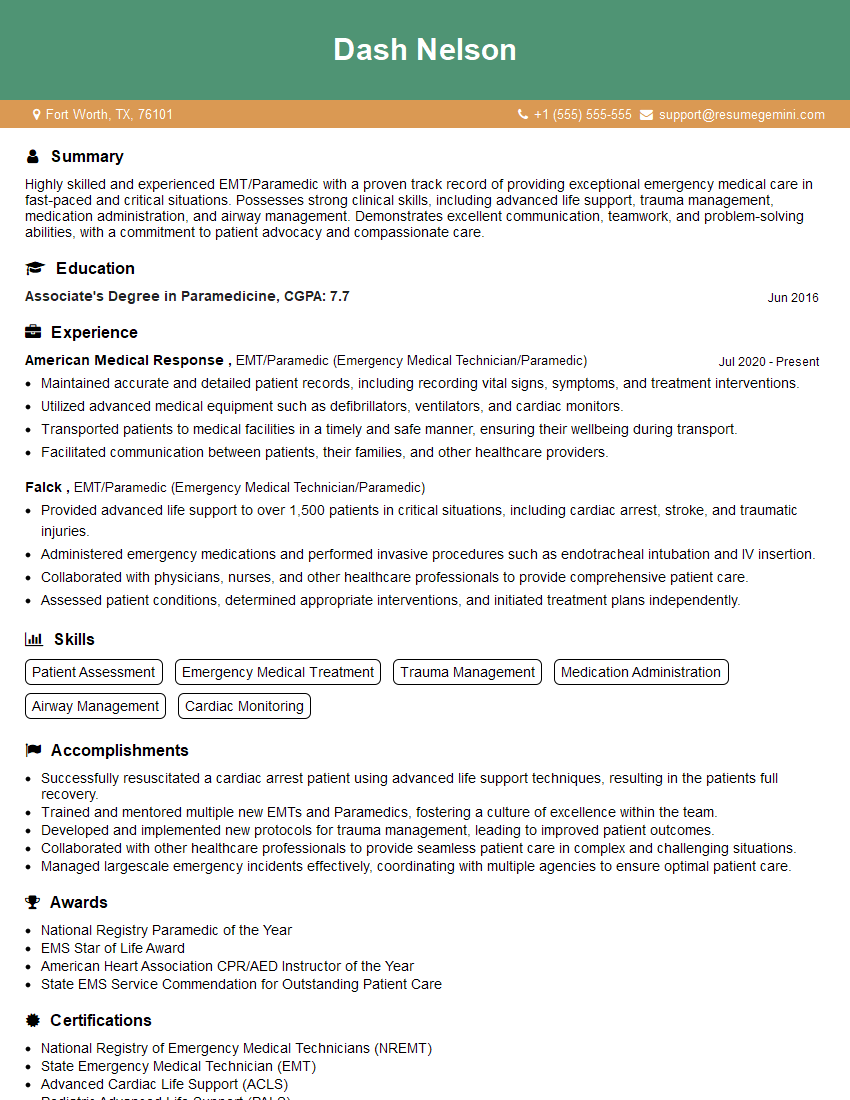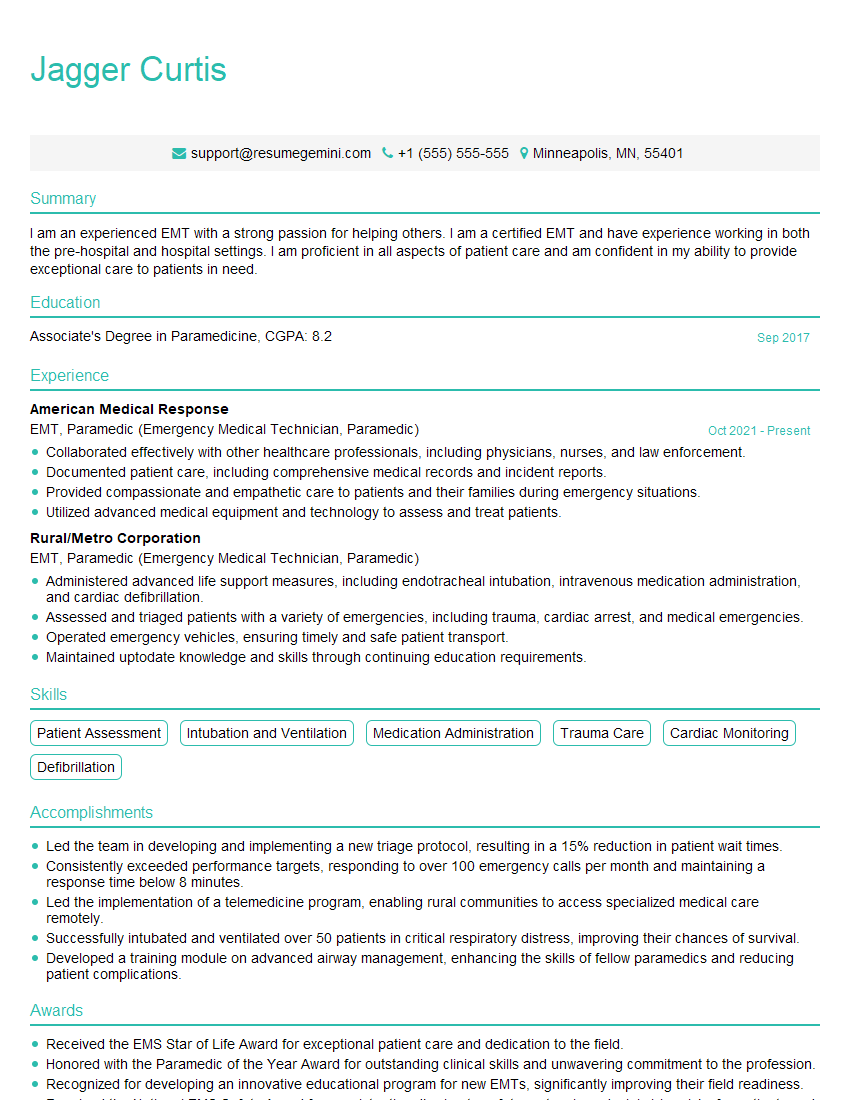Are you gearing up for an interview for a EMT/Paramedic (Emergency Medical Technician/Paramedic) position? Whether you’re a seasoned professional or just stepping into the role, understanding what’s expected can make all the difference. In this blog, we dive deep into the essential interview questions for EMT/Paramedic (Emergency Medical Technician/Paramedic) and break down the key responsibilities of the role. By exploring these insights, you’ll gain a clearer picture of what employers are looking for and how you can stand out. Read on to equip yourself with the knowledge and confidence needed to ace your next interview and land your dream job!
Acing the interview is crucial, but landing one requires a compelling resume that gets you noticed. Crafting a professional document that highlights your skills and experience is the first step toward interview success. ResumeGemini can help you build a standout resume that gets you called in for that dream job.
Essential Interview Questions For EMT/Paramedic (Emergency Medical Technician/Paramedic)
1. How do you assess a patient’s level of consciousness using the Glasgow Coma Scale (GCS)?
- Eye opening response: 4 points for spontaneous, 3 points for to verbal stimuli, 2 points for to painful stimuli, 1 point for no response.
- Verbal response: 5 points for oriented, 4 points for confused, 3 points for inappropriate words, 2 points for incomprehensible sounds, 1 point for no response.
- Motor response: 6 points for obeys commands, 5 points for localizes pain, 4 points for withdraws from pain, 3 points for flexor response, 2 points for extensor response, 1 point for no response.
2. Describe the proper steps for performing cardiopulmonary resuscitation (CPR) on an adult victim.
Establishing Unresponsiveness
- Check for responsiveness by tapping the patient’s shoulder and shouting.
- If no response, call for emergency medical services (EMS) immediately.
Checking for Breathing
- Look, listen, and feel for breathing for 5-10 seconds.
- If the patient is not breathing, open the airway using the head-tilt chin-lift maneuver.
Chest Compressions
- Place the heel of one hand on the center of the patient’s chest.
- Place your other hand on top of the first hand and interlace your fingers.
- Position yourself vertically above the patient’s chest.
- Compress the chest at a rate of 100-120 compressions per minute.
- Compress the chest to a depth of at least 2 inches.
Rescue Breathing
- After 30 chest compressions, give 2 rescue breaths.
- Pinch the patient’s nose closed and make a seal over their mouth.
- Give 2 slow breaths, each lasting about 1 second.
- Check for chest rise with each breath.
Continuing CPR
- Continue alternating between 30 chest compressions and 2 rescue breaths.
- Continue CPR until EMS arrives or the patient shows signs of life.
3. How do you manage a patient with a suspected spinal cord injury?
- Immobilize the patient’s head, neck, and spine using a cervical collar and backboard.
- Maintain the patient’s airway and breathing.
- Control any bleeding.
- Monitor the patient’s vital signs and neurological status.
- Transport the patient to the nearest trauma center.
4. Describe the signs and symptoms of a myocardial infarction (heart attack).
- Chest pain or discomfort that lasts for more than 15 minutes.
- Pain that is described as pressure, squeezing, or tightness.
- Pain that radiates to the neck, jaw, back, or arms.
- Shortness of breath.
- Lightheadedness or dizziness.
- Nausea or vomiting.
- Sweating.
- Rapid or irregular heartbeat.
5. How do you treat a patient with a suspected stroke?
- Call for EMS immediately.
- Monitor the patient’s vital signs and neurological status.
- Administer oxygen as needed.
- Control any seizures.
- Transport the patient to the nearest stroke center.
6. How do you assess a patient’s airway, breathing, and circulation (ABCs)?
- Airway: Check for any obstructions or injuries that may be blocking the airway.
- Breathing: Look, listen, and feel for breathing. If the patient is not breathing, open the airway and give rescue breaths.
- Circulation: Check for a pulse. If the patient does not have a pulse, begin CPR.
7. What are the different types of shock and how do you treat them?
- Hypovolemic shock: caused by a loss of blood or fluids. Treatment: administer intravenous fluids.
- Cardiogenic shock: caused by a heart attack. Treatment: administer oxygen, medications, and in some cases, perform CPR.
- Septic shock: caused by a severe infection. Treatment: administer antibiotics, fluids, and in some cases, vasopressors.
- Neurogenic shock: caused by a spinal cord injury. Treatment: immobilize the patient’s spine and administer fluids.
- Anaphylactic shock: caused by a severe allergic reaction. Treatment: administer epinephrine and antihistamines.
8. What are the different types of fractures and how do you treat them?
- Closed fracture: broken bone with no open wound.
- Open fracture: broken bone with an open wound.
- Comminuted fracture: broken bone with multiple fragments.
- Greenstick fracture: broken bone that is bent but not completely broken.
- Pathologic fracture: broken bone that is weakened by disease or infection.
- Stress fracture: broken bone that is caused by overuse.
- Treatment for fractures: immobilize the fracture, apply ice, elevate the injured limb, and administer pain medication.
9. What are the different types of burns and how do you treat them?
- First-degree burn: affects only the outer layer of skin.
- Second-degree burn: affects the outer and inner layers of skin.
- Third-degree burn: affects all layers of skin and may damage underlying tissue.
- Fourth-degree burn: affects all layers of skin and underlying tissue, including bone and muscle.
- Treatment for burns: cool the burn with water, cover the burn with a sterile dressing, and administer pain medication.
10. What are the different types of medical emergencies and how do you respond to them?
- Cardiac arrest: sudden loss of heart function.
- Stroke: sudden loss of brain function.
- Trauma: injury to the body caused by an external force.
- Poisoning: ingestion of a harmful substance.
- Overdose: ingestion of a large amount of a drug.
- Allergic reaction: reaction to an allergen.
- Seizure: uncontrolled electrical activity in the brain.
- Mental health emergency: a situation where a person is experiencing a mental health crisis.
- Response to medical emergencies: assess the situation, call for help, and provide first aid.
Interviewers often ask about specific skills and experiences. With ResumeGemini‘s customizable templates, you can tailor your resume to showcase the skills most relevant to the position, making a powerful first impression. Also check out Resume Template specially tailored for EMT/Paramedic (Emergency Medical Technician/Paramedic).
Career Expert Tips:
- Ace those interviews! Prepare effectively by reviewing the Top 50 Most Common Interview Questions on ResumeGemini.
- Navigate your job search with confidence! Explore a wide range of Career Tips on ResumeGemini. Learn about common challenges and recommendations to overcome them.
- Craft the perfect resume! Master the Art of Resume Writing with ResumeGemini’s guide. Showcase your unique qualifications and achievements effectively.
- Great Savings With New Year Deals and Discounts! In 2025, boost your job search and build your dream resume with ResumeGemini’s ATS optimized templates.
Researching the company and tailoring your answers is essential. Once you have a clear understanding of the EMT/Paramedic (Emergency Medical Technician/Paramedic)‘s requirements, you can use ResumeGemini to adjust your resume to perfectly match the job description.
Key Job Responsibilities
Emergency Medical Technicians (EMTs) and Paramedics are medical professionals responsible for providing pre-hospital emergency care to patients in critical or life-threatening situations. Their duties encompass a wide range of medical interventions and involve working in high-stress environments.
1. Patient Assessment and Stabilization
Respond to emergency calls, assess patients’ conditions, and provide immediate medical care.
- Collect vital signs, perform physical examinations, and obtain patient histories.
- Administer first aid, control bleeding, and provide pain relief.
- Stabilize patients’ conditions before transport to the hospital.
2. Emergency Transportation
Transport patients to hospitals or other medical facilities in a safe and timely manner.
- Operate emergency vehicles, adhering to traffic laws and safety regulations.
- Monitor patients’ conditions during transport, providing ongoing care as needed.
- Coordinate with hospital staff to ensure a smooth handover of patients.
3. Equipment and Medication Administration
Use a variety of medical equipment and administer medications to treat patients.
- Administer medications, including intravenous fluids, antibiotics, and pain medication.
- Operate medical devices, such as defibrillators, oxygen tanks, and ventilators.
- Maintain and inspect medical equipment to ensure it is in good working order.
4. Communication and Documentation
Effectively communicate with patients, family members, and medical professionals.
- Communicate clearly and compassionately with patients and their families.
- Document patient care, including assessments, treatments, and medications.
- Maintain accurate records of all emergency calls and medical interventions.
Interview Tips
Preparing thoroughly for an EMT/Paramedic interview can significantly increase your chances of success. Here are some essential interview tips to help you ace the interview:
1. Research the Organization and Position
Familiarize yourself with the organization’s mission, values, and the specific role you are applying for.
- Visit the organization’s website, read their annual reports, and research industry news.
- Identify the key responsibilities of the position and tailor your answers to highlight your relevant skills and experience.
2. Highlight Your Medical Skills and Experience
Emphasize your technical medical skills, including patient assessment, emergency care procedures, and medication administration.
- Quantify your experience by providing specific examples of successful patient interactions.
- Discuss your proficiency in using medical equipment and administering medications.
3. Demonstrate Compassion and Communication Skills
EMT/Paramedics play a vital role in providing care and support to patients and their families. Highlight your compassionate nature and communication abilities.
- Share anecdotes that demonstrate your empathy, understanding, and ability to connect with people.
- Emphasize your strong interpersonal skills and ability to communicate effectively with patients, families, and colleagues.
4. Prepare for Behavioral Questions
Behavioral questions are commonly used in interviews to assess your problem-solving, teamwork, and decision-making abilities.
- Review the STAR (Situation, Task, Action, Result) method for answering behavioral questions.
- Prepare examples that demonstrate your ability to handle stressful situations, work effectively in a team, and make sound judgments.
5. Ask Thoughtful Questions
Asking intelligent questions at the end of the interview shows your interest and engagement.
- Ask about the organization’s culture, opportunities for professional development, or specific aspects of the role.
- Avoid asking questions that are easily answered by researching the organization online.
Next Step:
Armed with this knowledge, you’re now well-equipped to tackle the EMT/Paramedic (Emergency Medical Technician/Paramedic) interview with confidence. Remember, a well-crafted resume is your first impression. Take the time to tailor your resume to highlight your relevant skills and experiences. And don’t forget to practice your answers to common interview questions. With a little preparation, you’ll be on your way to landing your dream job. So what are you waiting for? Start building your resume and start applying! Build an amazing resume with ResumeGemini.

